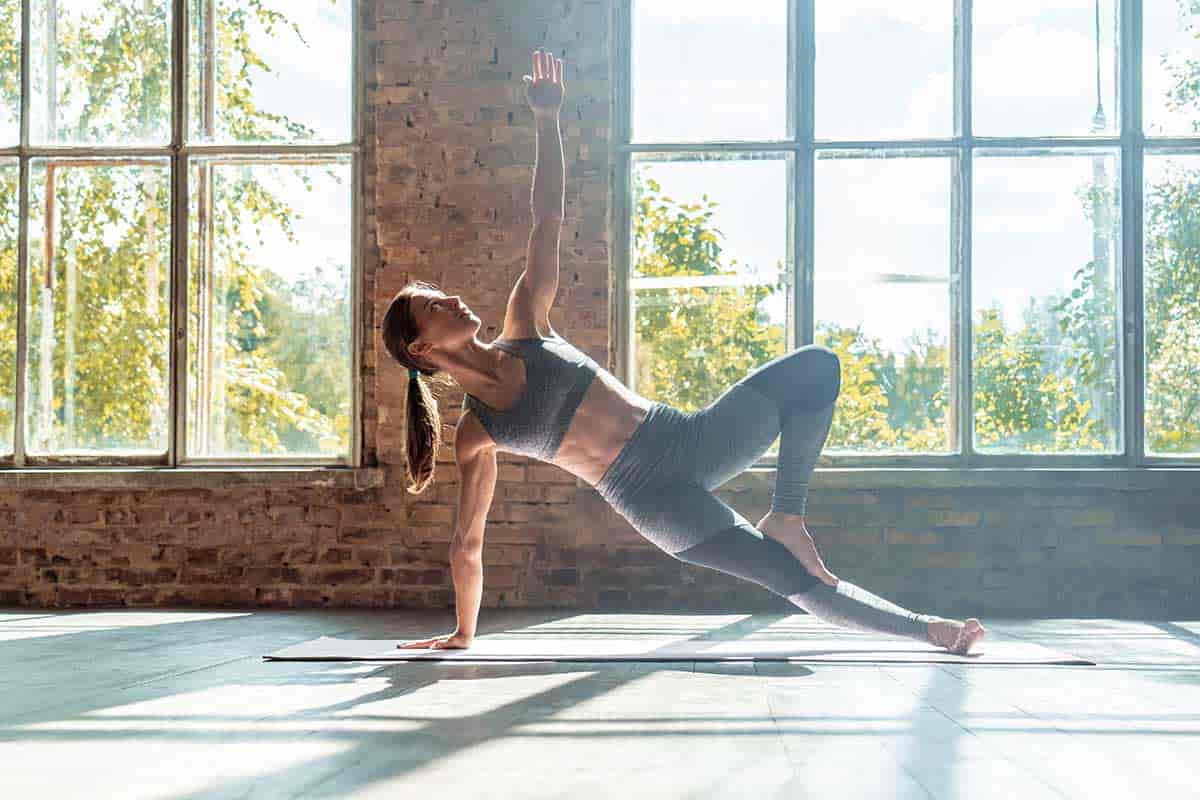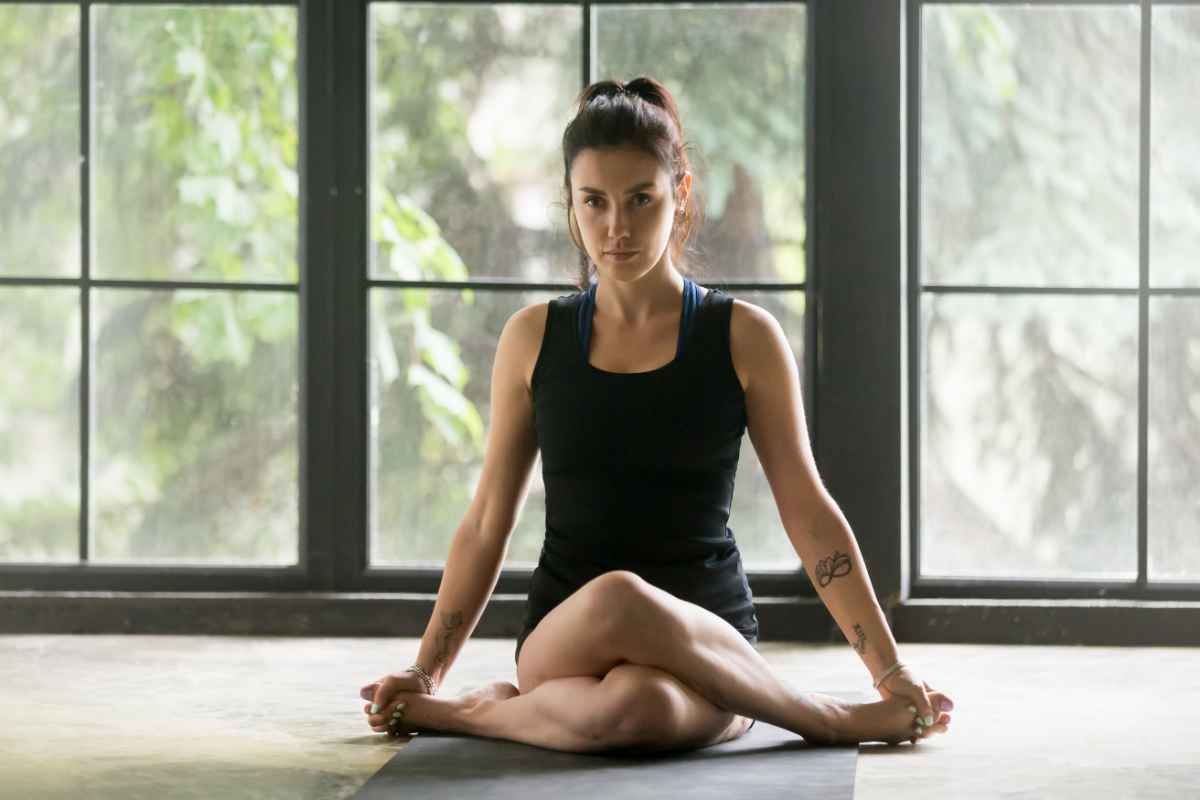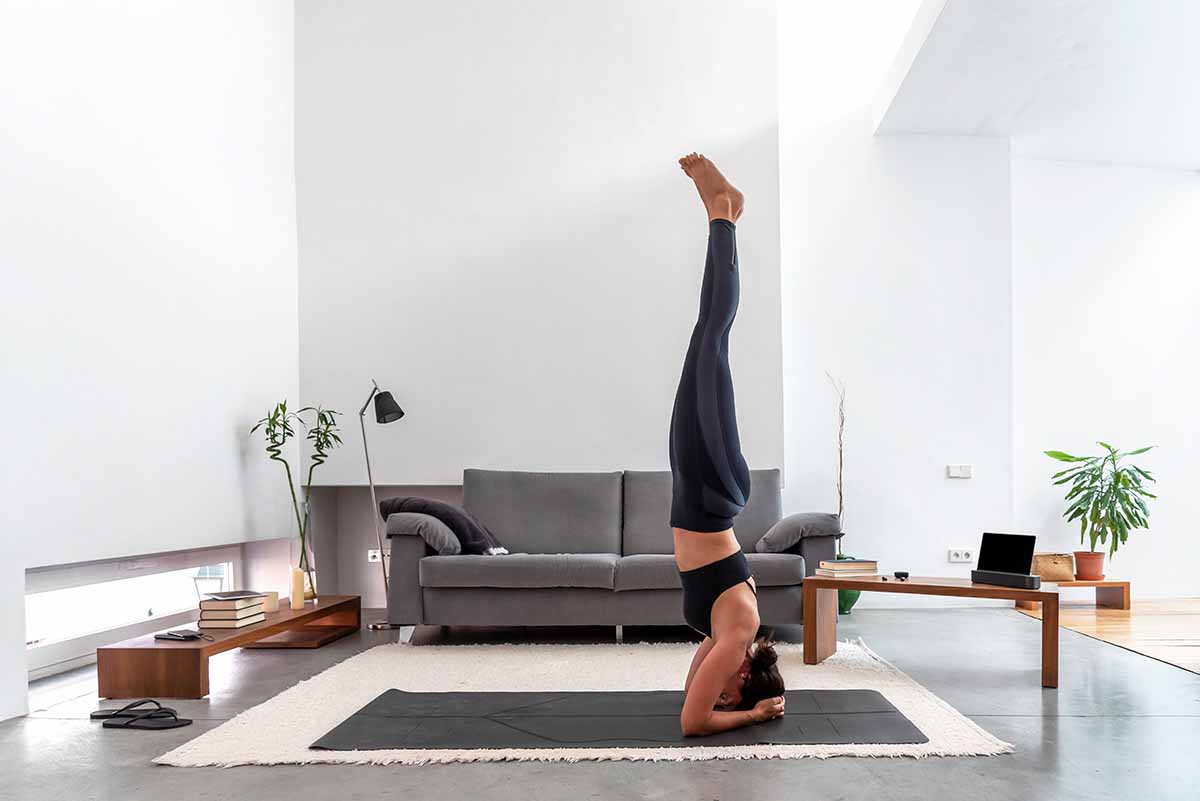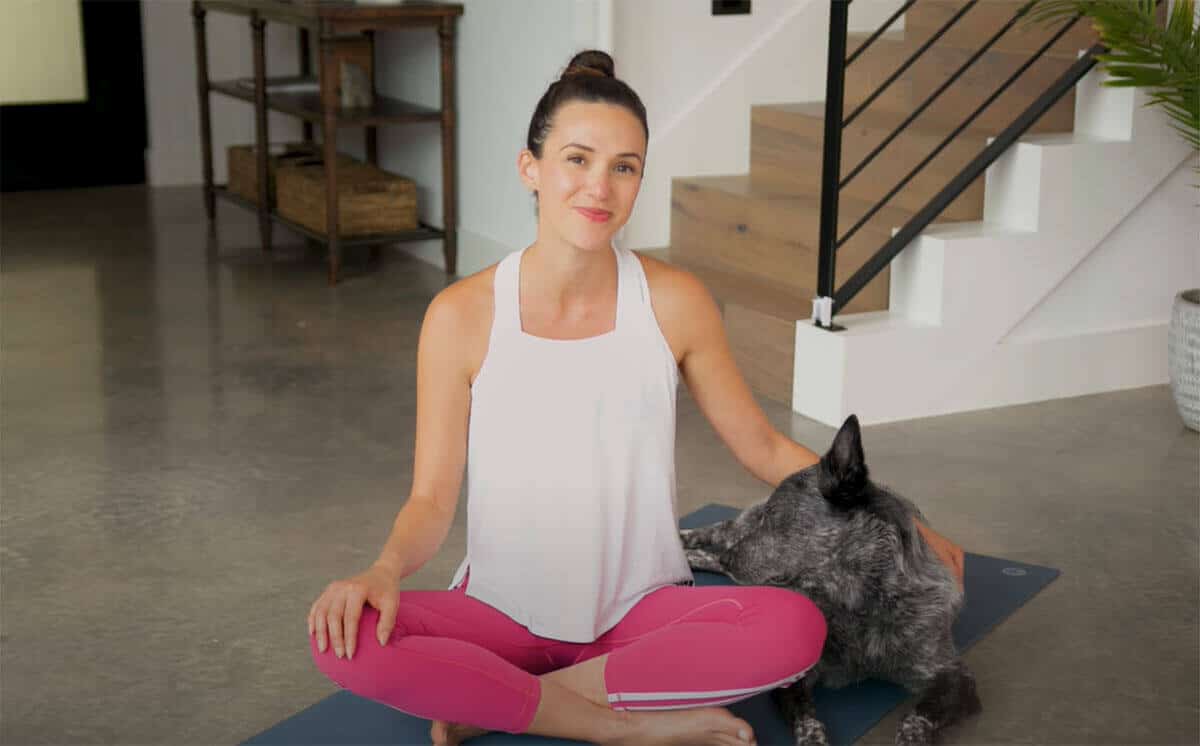
hat is the difference between Hatha and Vinyasa? It might be a bit confusing to know which style of yoga you should do. However, it's easy to understand the difference by learning how each type of yoga class operates differently.
Hatha Yoga is more focused on breathing or pranayama and poses, while Vinyasa Yoga focuses more on transitions between moves called asanas.
Read on to discover the differences between Hatha and Vinyasa Yoga and the advantages of each form. We will also discuss some examples of each, and which type of yoga may be best for beginners.
Article Topics
What's the difference between Hatha Yoga and Vinyasa?
Hatha Yoga and vinyasa yoga are very different. Hatha is a passive practice, meaning poses are held for longer periods which helps you focus on your breathing. On the other hand, Vinyasa is an active practice with shorter holds in various positions that help increase your heart rate and work out more muscles as well as keep up mental clarity due to vinyasa’s fast-paced nature.
The Principles of Hatha
Hatha Yoga is a type of yoga that focuses on the physical aspects and postures. Hatha yoga classes are named after the hatha yoga philosophy, emphasizing breathing and physical postures to help balance body energy.
Hatha yoga is a type of yoga where the emphasis is on physical postures and breathing. Hatha contains various poses performed in sequence, including standing poses, seated forward bends (like lunges), twists, backbends (like cobra or bow pose), and balancing poses like tree or warrior II.
The focus is not on repetition, as seen with an Ashtanga practice but instead using muscle control to maintain each posture for three to five breaths before moving into the next one. Hatha also includes meditation techniques such as pranayama, which are done at the end of class after savasana to reach final relaxation. Practitioners may take up hatha yoga if they want more flexibility from their yoga routine without the intense flow of Ashtanga practice.
Hatha means “sun,” and the sun is a metaphor for:
- Life
- Energy
- Creativity
- Warmth
- Fulfillment
A hatha yoga class consists of postures (asanas) held for three to five breaths between each pose before moving on to the next one in sequence with meditation techniques at the end or after savasana.
The Principles of Vinyasa
Vinyasa is a form of hatha yoga that incorporates poses in sync with breath cycles. There’s also:
- Ashtanga (athletes flow)
- Power vinyasa (intense flowing practice)
- Restorative hatha yoga (gentle therapeutic style).
In vinyasa, one moves from pose to pose, holding each for a few seconds before moving to the next. It creates an internal heat in your body while you’re doing it because you are giving everything 100% effort and pushing yourself physically. It also helps build strength while working all parts of your body and stretching them out, so they become more flexible.
Vinyasa can be as fast-paced or slow, intense or gentle, depending on your preferences. It helps increase mental clarity. It’s an excellent exercise for physical fitness and weight loss and has many therapeutic effects. The best part about vinyasa is there’s something everyone can enjoy, even if you don’t have any specific health goals.
The poses help provide mental clarity, which means vinyasa can be meditative depending on how much focus you put into it when practicing vinyasa. In addition, Vinyasa is often practiced in hot rooms, and it gets your blood pumping quickly, making vinyasa an excellent option for physical fitness as well as mental clarity!
Is Hatha Yoga harder than Vinyasa?
Hatha Yoga can be more challenging for beginners that aren’t used to the poses used in practice. Hatha yoga is slower and more methodical, emphasizing poses that stretch the entire length of your body from head to toe. Hatha also incorporates a lot of breathing techniques for relaxation. On the other hand, Vinyasa is faster-paced and has you flowing through various postures in rapid succession.
Hatha focuses on lengthening muscles while still giving them an intense workout. Hatha is also great for beginners because it’s slower-paced and doesn’t force you to learn a series of poses like vinyasa does. Vinyasa focuses more on building strength than lengthening muscles while still giving them an intense workout.
Some vinyasa instructors will argue that if hatha yoga is practiced at a pace that’s too slow, it can be more difficult for the student to hold the poses.
What's an example of Hatha Yoga?
In hatha yoga, you’ll often see poses such as downward-facing dog and plank. This is a slower-paced form of yoga that focuses on stretching more than anything else. Time and attention to form are crucial in this type of hatha yoga class because it emphasizes stretching over power.
Examples of poses used in Hatha Yoga include:
- The cobra pose, which stretches the muscles in your chest and abdomen.
- The lizard pose opens up your hip flexors which improves blood flow through the pelvis area.
- Bow Stretch for stretching out all of those rear leg muscles often neglected during a Vinyasa practice.
- Yoga Nidra is a Hatha practice where one remains in savasana for as long as they wish to receive the benefits of restful sleep.
These poses are held for more extended amounts of time to focus on deep stretching while bringing attention to the breath, one of the principles of Hatha Yoga. Hatha Yoga is a calm and slow type of yoga.
What's an example of a Vinyasa Yoga Flow?
Vinyasa Yoga emphasizes synchronizing breath with movement to establish and maintain the flow of vital energy (prana) throughout the body. Vinyasa Yoga is more focused on transitions between moves, which are called asanas.
At its essence, vinyasa means “to flow” in Sanskrit, so this style emphasizes movement within each pose while maintaining a constant breath pattern throughout the routine. Vinyasa flows from one posture into another by linking movements with synchronized breaths, hence the name “Vinyasa” (flow).
To perform Vinyasa yoga, first, find a comfortable sitting position in which you can quickly move from one pose to the next with little difficulty. This may mean that certain positions are not good options because they will require too much physical exertion. Then, to begin vinyasa, take three deep breaths and consciously bring your awareness into each moment.
As you start moving through the poses during vinyasa, it’s essential to return your awareness back to your breath when your mind begins wandering. Be sure to take time between each pose for deep breaths before moving on.
Various poses are used in Vinyasa, some more difficult than others, and some as a set in a series of poses. Some examples of Vinyasa yoga poses include:
- Sun salutation series (often called Surya Namaskar) where one moves from standing into various postures like downward dog or child’s pose while completing 12 rounds. This is followed by one final sequence known as savasana.
- Moon Salutations can be similar but are often done with vinyasa yoga poses like the Warrior series and boat pose.
- Triangle Pressing upwards and outwards to strengthen shoulders and chest muscles.
- Mountain Climber in a tabletop position.
- Warrior II Poses that stretch the hamstrings and hip flexors.
These poses in Vinyasa Yoga are typically done in quick succession while focusing on breathing. As a result, Vinyasa Yoga poses promote both strength and cardiovascular training rather than stretching.
Listening to music is also a great way to practicing your vinyasa flow! Check out the best vinyasa yoga flow music videos in that article!
Advantages of Hatha Yoga vs. Vinyasa
The purpose of Hatha as a form of exercise isn’t about getting into shape or looking better it’s primarily focused on building:
- Strength
- Flexibility
- Balance
Hatha yoga training is effective at reducing anxiety levels. Hatha Yoga is a hathapradipika, or “light on Hatha.” It was used by Indian yogis who were seeking enlightenment through meditation practices. The goal of Hatha is not physical fitness but rather spiritual development.
Hatha practitioners may use one or more breathing exercises (pranayama) to control their energy and access higher levels of consciousness during practice. While Vinyasa might offer you some other positives like an increased heart rate, Hatha Yoga offers something different entirely: mental clarity. With its focus on stretching all parts of your body and attention to the union of the body and mind, mental calm can be a result of Hatha Yoga.
Is Hatha Yoga or Vinyasa Best for Beginners?
Hatha yoga might be a better option for beginners since they teach students to breathe properly from their stomachs, which allows them to understand how much air they need to maintain a good posture. Hatha Yoga is a good starting point to understand the basics of Yoga posing and the philosophy behind the practice.
On the other hand, Vinyasa yoga is better for professional dancers or athletes looking for strength training and speed, so that Vinyasa might be more beneficial in the long run. Vinyasa may be the best option for those that have been through and master the Hatha Yoga practice. Vinyasa is a much more challenging routine than Hatha.
Either yoga style is perfect for seniors. They are two of the most common yoga styles for seniors. To find a great online yoga class for seniors, check out that article!
Conclusion
Hatha Yoga is focused on the physical aspects and postures. Hatha yoga also has an emphasis on breathing techniques or pranayama. This type of yoga can be suitable for beginners because it emphasizes a slower pace that helps with alignment and teaches safe poses to avoid injury. Hatha Yoga may be better suited to those new to the practice because it focuses on breathing and poses.
With Vinyasa Yoga, you continuously move from one pose into another, so there’s not as much time spent in a single position. If you’re interested in trying Hatha or Vinyasa Yoga, we recommend that you go with whichever appeals more to your personality. As long as you do some research before teaching yourself either style of yoga at home, both should work well for beginners!
(If you feel like teaching yoga to people, you might want to look into online yoga certifications!)



